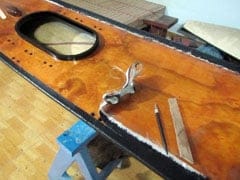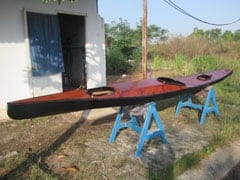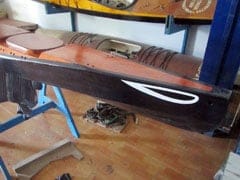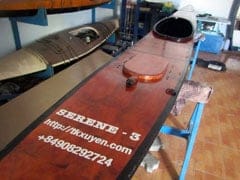 t is on the list! To quote the upside down text 😬 (to be read when you’re already bottom-up): the same lines which represented the starting position now represent a fish-eye view of the fully capsized position. The phantom lines represent the upright position, or goal. To right himself, the kayaker:
t is on the list! To quote the upside down text 😬 (to be read when you’re already bottom-up): the same lines which represented the starting position now represent a fish-eye view of the fully capsized position. The phantom lines represent the upright position, or goal. To right himself, the kayaker:
1. Flicks his wrists to swing his knuckles toward his face, thus causing the outboard edge of the paddle to assme a slight planing angle (not show) with the water surface. The remaining steps constitute one continuous movement, to be done as quickly as possible.
2. With his hips and right hand serving as pivot points, he sweeps his forward paddle blade, and his torso, outward in a 90-degree planing arc on the water surface, as shown from position 1 to 3, while pulling down on his left hand and pushing up on his right, thus lifting himself to the surface.
3. Complete the roll by flicking his wrists to flatten the blade angle, then sharply increasing his opposing hand pressures, thus raising himself in a chinning attitude as the paddle blade sinks and is drawn inward. The roll is now completed.

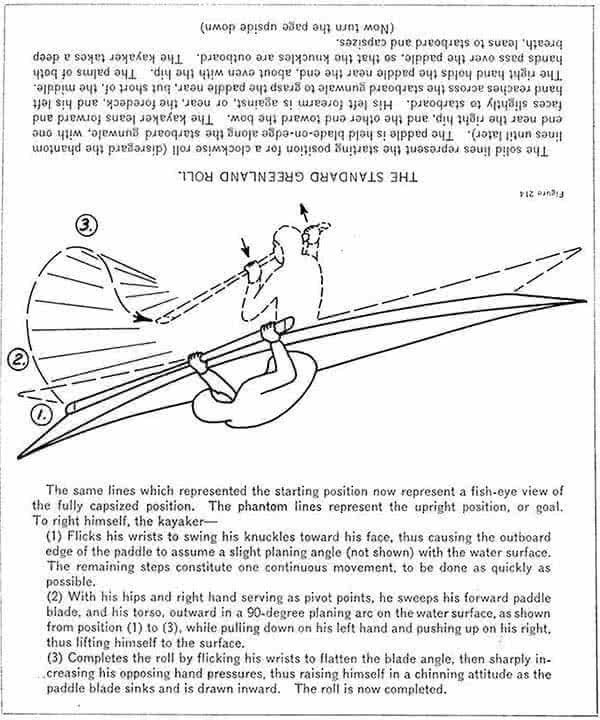
 ường thẳng có phải là đường ngắn nhất giữa hai điểm!? Nhớ lại hành trình chèo 9 ngày qua 9 cửa sông Cửu Long hai năm trước… tôi luôn cố đi thật xa, không được ôm bờ (shore hugging) quá gần. Nhưng nó gần như là một phản xạ vô hình, một tiềm thức về sự an toàn, khi cứ sau 1, 2 giờ chèo lại thấy mình đi gần sát lại bờ. Khi trong con người mình không có đủ sự tự tin, tin vào thể lực, vào khả năng xoay xở của bản thân, tin vào độ an toàn, bền chắc của các thiết bị trên thuyền, thì gần như là một phản xạ tự nhiên không thể khác, cứ chèo một lúc là lại đi gần bờ.
ường thẳng có phải là đường ngắn nhất giữa hai điểm!? Nhớ lại hành trình chèo 9 ngày qua 9 cửa sông Cửu Long hai năm trước… tôi luôn cố đi thật xa, không được ôm bờ (shore hugging) quá gần. Nhưng nó gần như là một phản xạ vô hình, một tiềm thức về sự an toàn, khi cứ sau 1, 2 giờ chèo lại thấy mình đi gần sát lại bờ. Khi trong con người mình không có đủ sự tự tin, tin vào thể lực, vào khả năng xoay xở của bản thân, tin vào độ an toàn, bền chắc của các thiết bị trên thuyền, thì gần như là một phản xạ tự nhiên không thể khác, cứ chèo một lúc là lại đi gần bờ.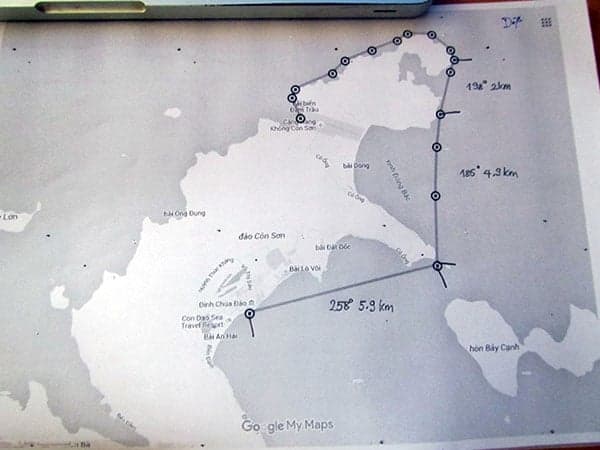
 ác ống nhòm quân sự hay hàng hải chuyên dụng thường có thang đo hiển thị trên khung nhìn, dùng để ước lượng khoảng cách. Mỗi nấc thang đo có đơn vị là mil (mili-radian – 1/1000 radian). Giả sử như biết trước chiều cao của đối tượng đang quan sát (e.g: một ngọn núi) là x, thì khoảng cách tới đó: y = x / k * 1000, với k là giá trị đọc được trên thang đo.
ác ống nhòm quân sự hay hàng hải chuyên dụng thường có thang đo hiển thị trên khung nhìn, dùng để ước lượng khoảng cách. Mỗi nấc thang đo có đơn vị là mil (mili-radian – 1/1000 radian). Giả sử như biết trước chiều cao của đối tượng đang quan sát (e.g: một ngọn núi) là x, thì khoảng cách tới đó: y = x / k * 1000, với k là giá trị đọc được trên thang đo.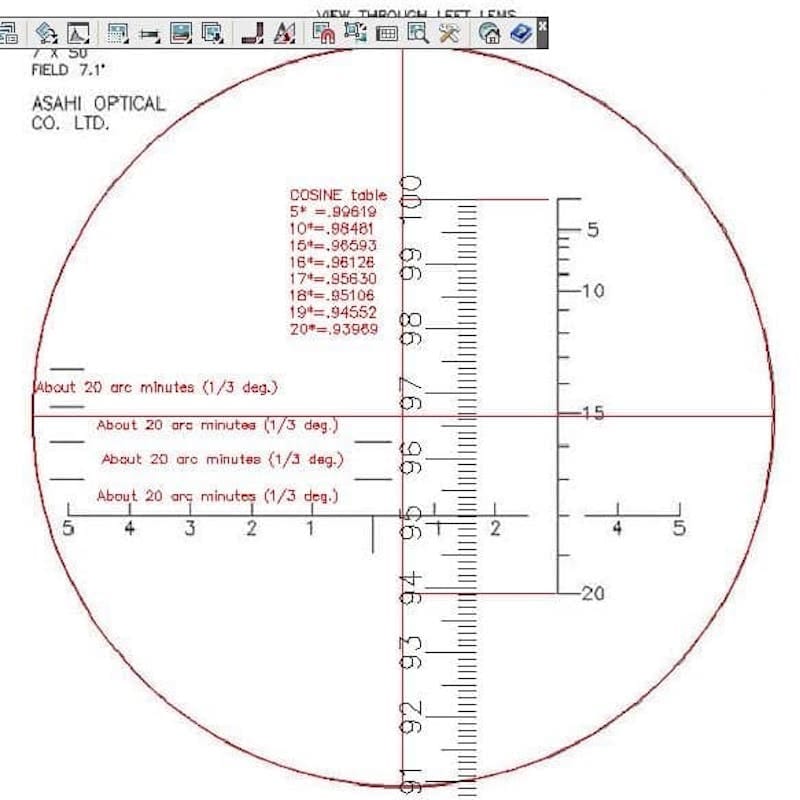
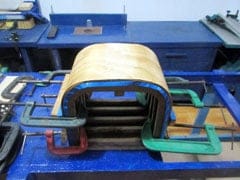
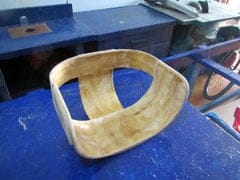
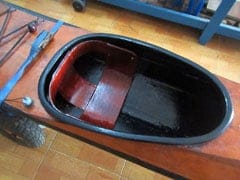
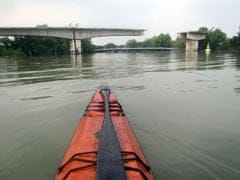
 etween the trials, I managed to complete a couple of things. First is to mount the compass, the tried – and – true type of compass used in all boats of the Serene series, this without an internal lighting. Then, I built another paddle, a simple one with rattan shaft, and plywood blades, a little bit bigger, weights at 1.1 kg, slightly heavier than the Greenland companion – my “storm paddle”, 0.9 kg. Still considered an Euro – type paddle, but with a smaller blade to resemble Greenland style.
etween the trials, I managed to complete a couple of things. First is to mount the compass, the tried – and – true type of compass used in all boats of the Serene series, this without an internal lighting. Then, I built another paddle, a simple one with rattan shaft, and plywood blades, a little bit bigger, weights at 1.1 kg, slightly heavier than the Greenland companion – my “storm paddle”, 0.9 kg. Still considered an Euro – type paddle, but with a smaller blade to resemble Greenland style.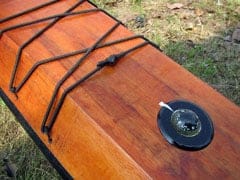
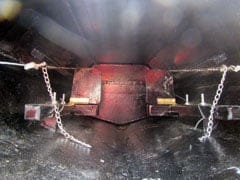
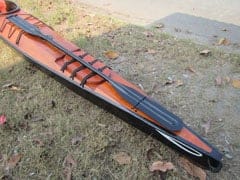
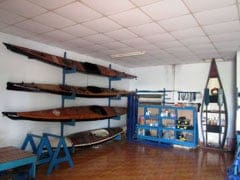
 aunch the boat today, first day of the year 2018 😀! Took the kayak out to water on a sunny, breezy afternoon for a 12 km paddling, the temperature was around 25 ~ 27 Celsius, considered “cool” with this hot – all – around – the – year tropical climate. The short paddling is just to get some first impressions, to check if everything works, and how it feels, the new hull shape, something radically different from my previous boats. Yet all confirms things I’d known from the design phase.
aunch the boat today, first day of the year 2018 😀! Took the kayak out to water on a sunny, breezy afternoon for a 12 km paddling, the temperature was around 25 ~ 27 Celsius, considered “cool” with this hot – all – around – the – year tropical climate. The short paddling is just to get some first impressions, to check if everything works, and how it feels, the new hull shape, something radically different from my previous boats. Yet all confirms things I’d known from the design phase.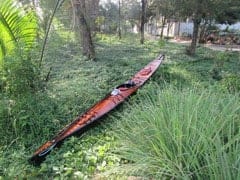
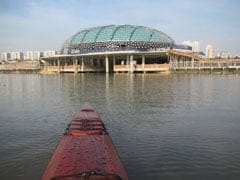
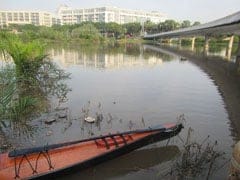
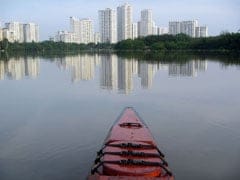
 lmost ready for the water, but the tide is unfavorable for the weekend (its heights are at night), and the Tembin cyclone is crossing the East sea, threatening the area. So I take the time to complete a couple more things. Attaching the electric box through cable gland is quite straight forward, everything works out right, in essence the bilge pump and reed switch. I added one master switch to the electric circuit, in order to turn everything off and not to drain the 18650 batteries to exhaustion.
lmost ready for the water, but the tide is unfavorable for the weekend (its heights are at night), and the Tembin cyclone is crossing the East sea, threatening the area. So I take the time to complete a couple more things. Attaching the electric box through cable gland is quite straight forward, everything works out right, in essence the bilge pump and reed switch. I added one master switch to the electric circuit, in order to turn everything off and not to drain the 18650 batteries to exhaustion.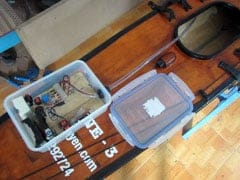
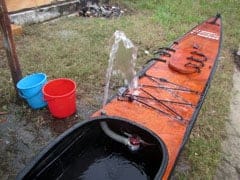
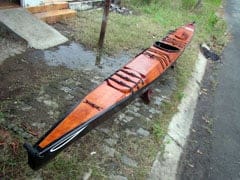
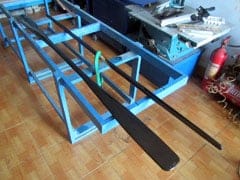
 askets fabrication: the critical thing in a hatch’s waterproofness is its gasket, and I realized that the best material for gasket is silicone: flexible, durable and offer a very good fit. And for a custom size and shape hatch, somehow I’ll need to make the gaskets too. It turned out to be pretty much easy, using the 2 – parts silicone available here on local market. You mix up component A to component B (catalyst, around 1 ~ 4 % by weight) and pour it into a mold, wait for about 2 hours, and it’s done.
askets fabrication: the critical thing in a hatch’s waterproofness is its gasket, and I realized that the best material for gasket is silicone: flexible, durable and offer a very good fit. And for a custom size and shape hatch, somehow I’ll need to make the gaskets too. It turned out to be pretty much easy, using the 2 – parts silicone available here on local market. You mix up component A to component B (catalyst, around 1 ~ 4 % by weight) and pour it into a mold, wait for about 2 hours, and it’s done.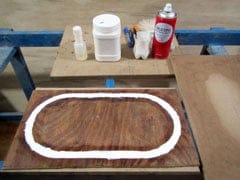

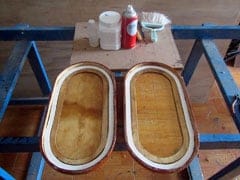
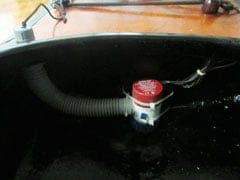
 irst image: the aft deck hatch, secured by 3 belt locks. These locks are usually found on your backpacks, and while they are a bit cumbersome to install, they offer quite some holding power and downward pressure, which is essential for the silicone gaskets inside the hatches’ lids to properly work (would mention about those gaskets in the next post). Similar locking for the forward hatch (2nd image). There’re 3 locks per hatch, so if one failed, the other two could still full – fill their duty.
irst image: the aft deck hatch, secured by 3 belt locks. These locks are usually found on your backpacks, and while they are a bit cumbersome to install, they offer quite some holding power and downward pressure, which is essential for the silicone gaskets inside the hatches’ lids to properly work (would mention about those gaskets in the next post). Similar locking for the forward hatch (2nd image). There’re 3 locks per hatch, so if one failed, the other two could still full – fill their duty.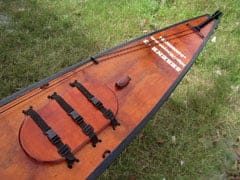
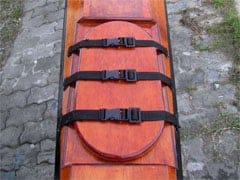
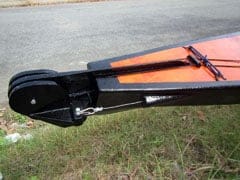
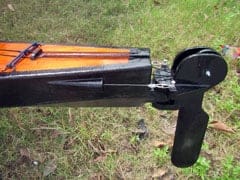
 ne more lesson learnt: we can thin the epoxy when glassing too, sometimes the epoxy has such high viscosity (e.g epoxy from the bottom of the container) that it’s a bit hard to wet out the fiberglass, so I added some xylene solvent (less than 1/4 by weight), so that the glassing could go on easier, and the curing time is also prolonged, an important factor in hot tropical weather. Don’t worry about not having enough epoxy inside the fiber, cause we would usually have another fill coat anyhow.
ne more lesson learnt: we can thin the epoxy when glassing too, sometimes the epoxy has such high viscosity (e.g epoxy from the bottom of the container) that it’s a bit hard to wet out the fiberglass, so I added some xylene solvent (less than 1/4 by weight), so that the glassing could go on easier, and the curing time is also prolonged, an important factor in hot tropical weather. Don’t worry about not having enough epoxy inside the fiber, cause we would usually have another fill coat anyhow.